- Home /
- Resources /
- Learning center /
- Intro to Fabric Cl...
Intro to Fabric Cloud Router (FCR)
Discover what Equinix Fabric Cloud Router is, what it's for and why you'd use it

On this page
Equinix Fabric Cloud Router (FCR) is a powerful managed routing service to interconnect and manage your Equinix Fabric Virtual Connections (VCs). Using the powers of the managed routing services greatly simplifies the management of your connections, provides a single point for routing configuration, enables you to build a global routing mesh among all of your Fabric VC endpoints anywhere in the world and can save you costs.
In this guide, we will show you what FCR is, how it works, and when to use it. In future guides, you will use FCR to interconnect Fabric endpoints, first in a single region and then in a global mesh.
What is Equinix Fabric?
Let's start with a brief review of Equinix Fabric.
Equinix Fabric is a global high-speed managed private network, connecting thousands of endpoints in dozens of metros around the word. Equinix IBX data centers, Equinix Metal, other cloud providers, SaaS providers and other services are all connected to Fabric.
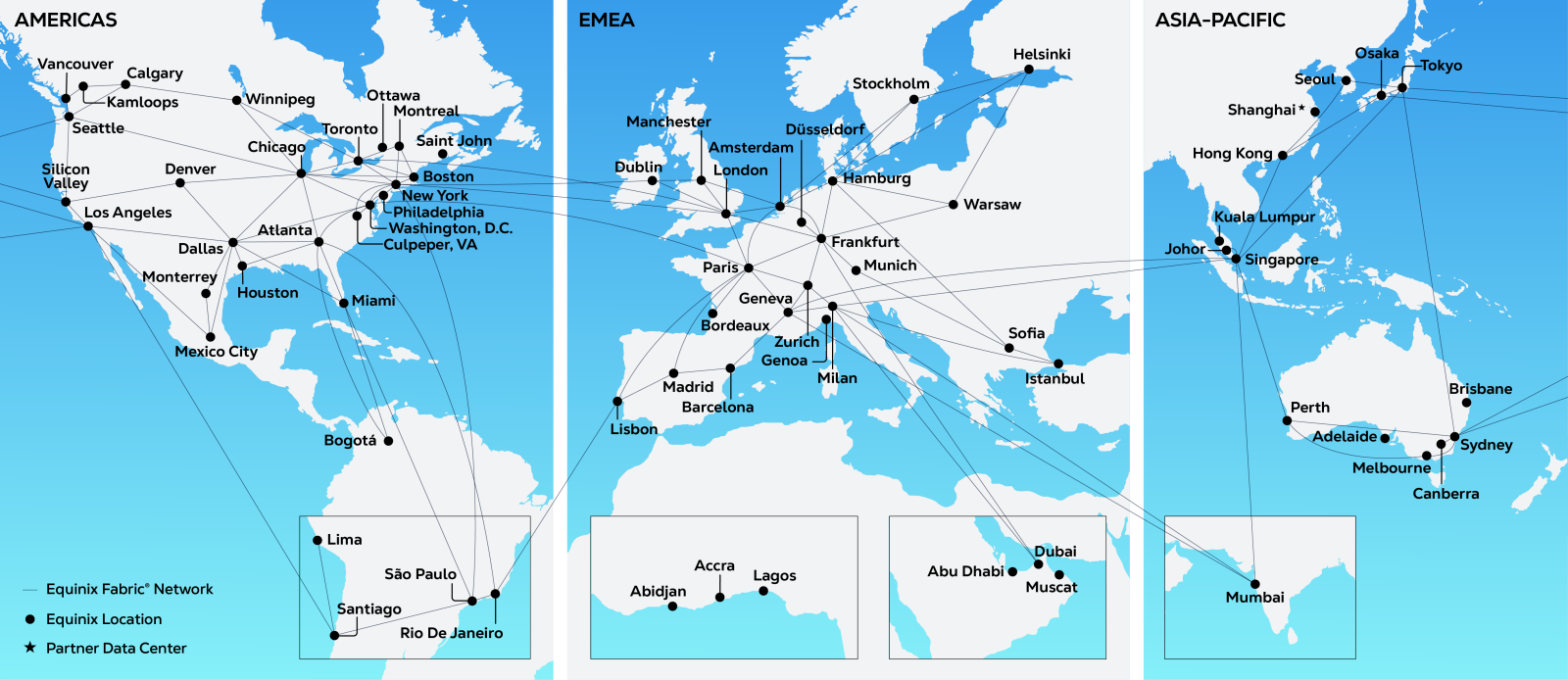
In Fabric, you create Virtual Connections (VCs), private point-to-point connections between those endpoints, dedicated solely to you. As long as you have an account and the right permissions on an endpoint that is connected to Fabric, it is available for you to make a virtual connection. For example, in an Equinix IBX, you need to have a port; in AWS, Azure or Google Cloud, you need to have an account with access to the appropriate interconnection resource in that cloud.

One end of a VC always connects to an Equinix endpoint, such as an Equinix IBX port or Equinix Metal, while the other end can be Equinix or any service or cloud provider. For redundancy, you can create multiple VCs between the same endpoints.

What is Equinix Fabric Cloud Router?
Like any networking, the number of point-to-point connections grows much faster than the number of endpoints.
- 2 endpoints need 1 connection
- 3 endpoints need 3 connections
- 4 endpoints need 6 connections
- 5 endpoints need 10 connections
You can see that the number of connections grows much more quickly than the number of endpoints. This is the complete graph, or n(n-1)/2 problem.

In this example deployment, there are just 6 endpoints, and 15 connections! Each connection requires effort, incurring setup costs and management costs, in addition to the direct costs of the connection itself and each endpoint. Whether it's an Equinix IBX port, AWS Direct Connect, or Google Cloud Interconnect, each connection has monthly fees.
Beyond the connections themselves, you need to manage routing: Which networks are allowed to connect to which? What kind of traffic will go through? How does one network know about and find all of the others? Even with just a small number of connections, the number of places you need to manage routing and controls can grow quickly.
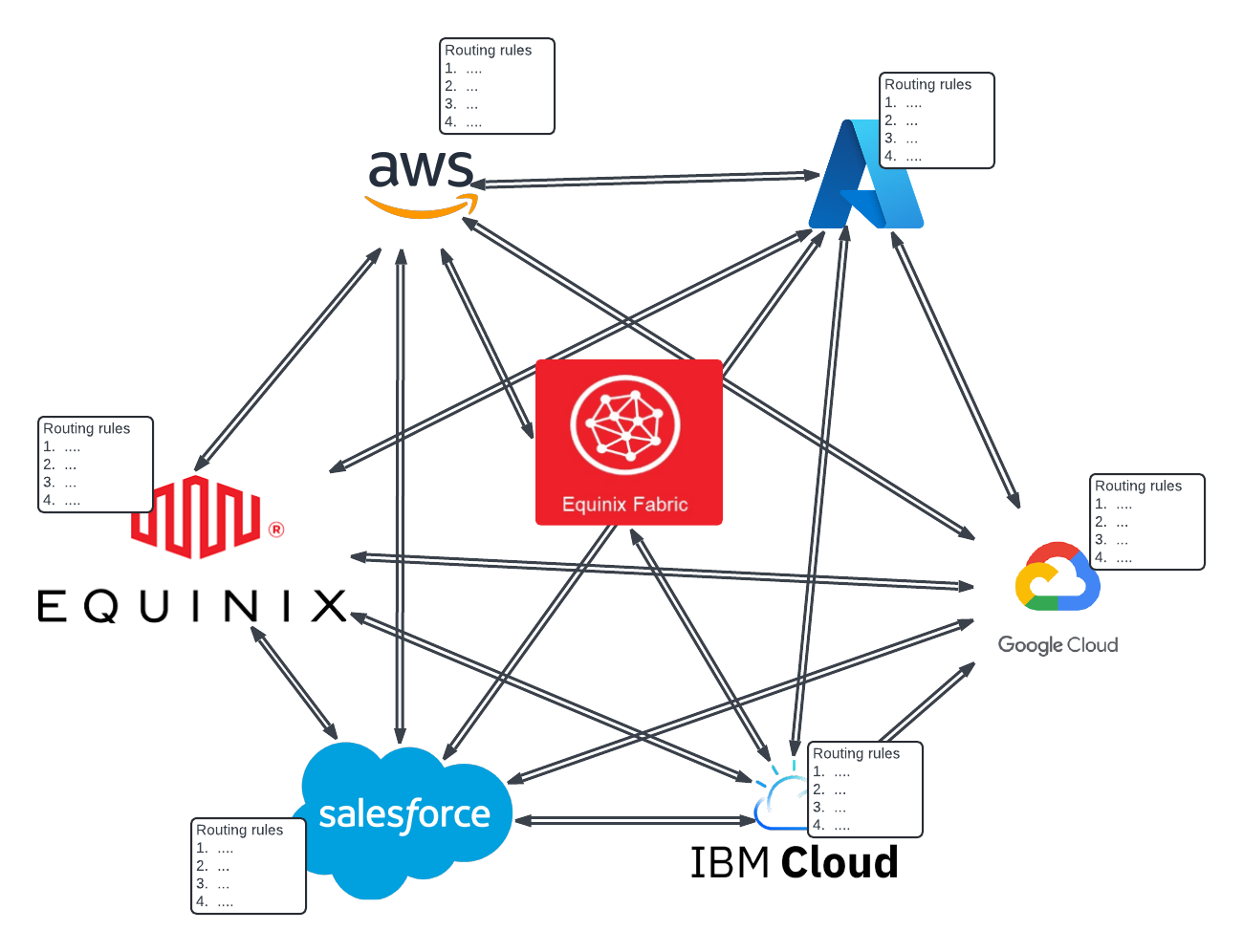
Equinix Fabric Cloud Router (FCR) helps solves these problems for you.
First, by providing a single central connection point, you connect each endpoint just to the FCR. This eliminates most of the costs related to multiple connections, both direct costs, such as connection fees and endpoint charges, and labour costs, such as setup and management effort.
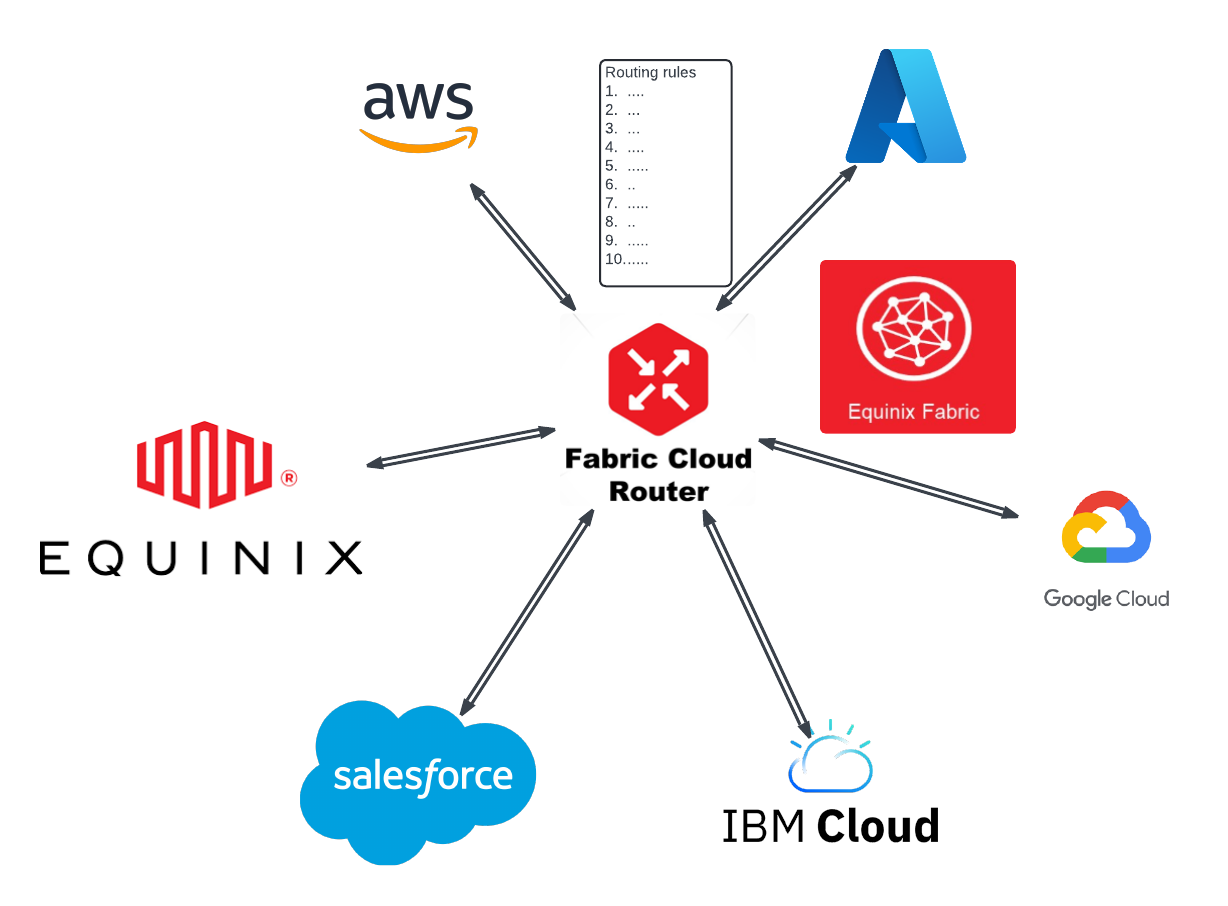
Second, by routing all connections through the FCR, you have a single point to manage all of the routing and controls. You can define which networks are allowed to connect to which, what kind of traffic will go through, and how each network finds all of the others. This greatly simplifies routing effort. It also provides you with precise knowledge of all of the connections and traffic flows, which is essential for auditing and compliance.
Third, while one end of a VC must be an Equinix endpoint, FCR qualifies as that endpoint. Using FCR opens up options to connect cloud providers and service providers across the world, without needing to connect to an Equinix facility.
So, while this connection diagram really wouldn't work, because you are trying to connect non-Equinix service providers directly:

This one absolutely would work, because you are connecting all of the endpoints to the FCR, and the FCR manages the routing and controls:

Going Global
FCRs are great for managing connections within a specific region. How do you manage connections across regions, or even across the world? How do you connect AWS in us-east-1 (Washington) to Equinix LD5 (London), or Azure in West US (Silicon Valley) to Equinix Metal in Hong Kong?
Equinix Fabric provides a global private IP network called IP-WAN. With IP-WAN, you create your own private global mesh network, connecting multiple FCRs across metros.
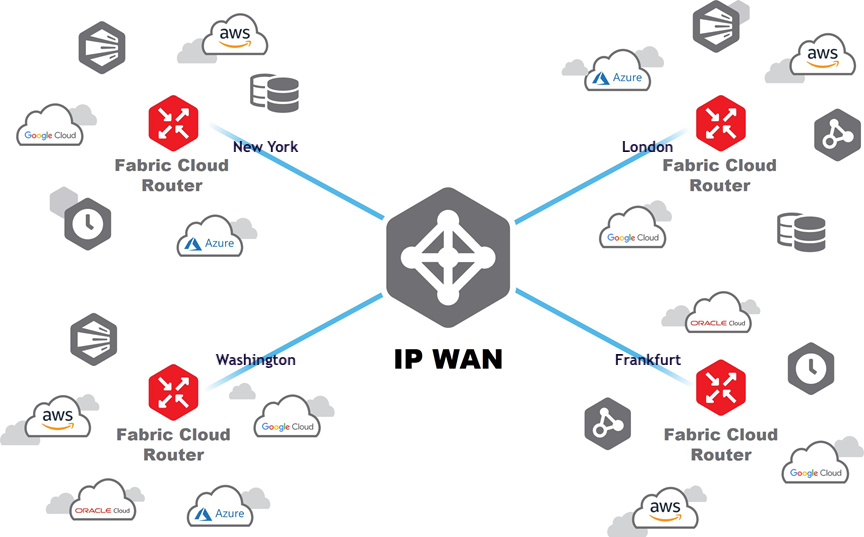
By combining VCs, FCRs and IP-WAN, you create a powerful, cost-effective, easy-to-run private global network, connecting all of your endpoints across the world and across providers - Equinix IBX, Equinix Metal, other cloud providers, SaaS providers and more - with simple-to-use routing and controls, and precise knowledge of all of the connections and traffic flows.
When should I use FCR?
FCR is particularly useful in several use cases.
First, if you have multiple VCs in a region interconnecting with the same endpoints, FCR can greatly simplify routing and control, with the added benefit of a reduced number of connections, and therefore costs. Let's look again at our example from the beginning of this guide. We interconnected AWS, Azure, Google Cloud, IBM Cloud, Salesforce and Equinix, just six endpoints. If you count the connections, though, you see that it is 15 connections, or 30 if you want redundancy, which we always recommend.
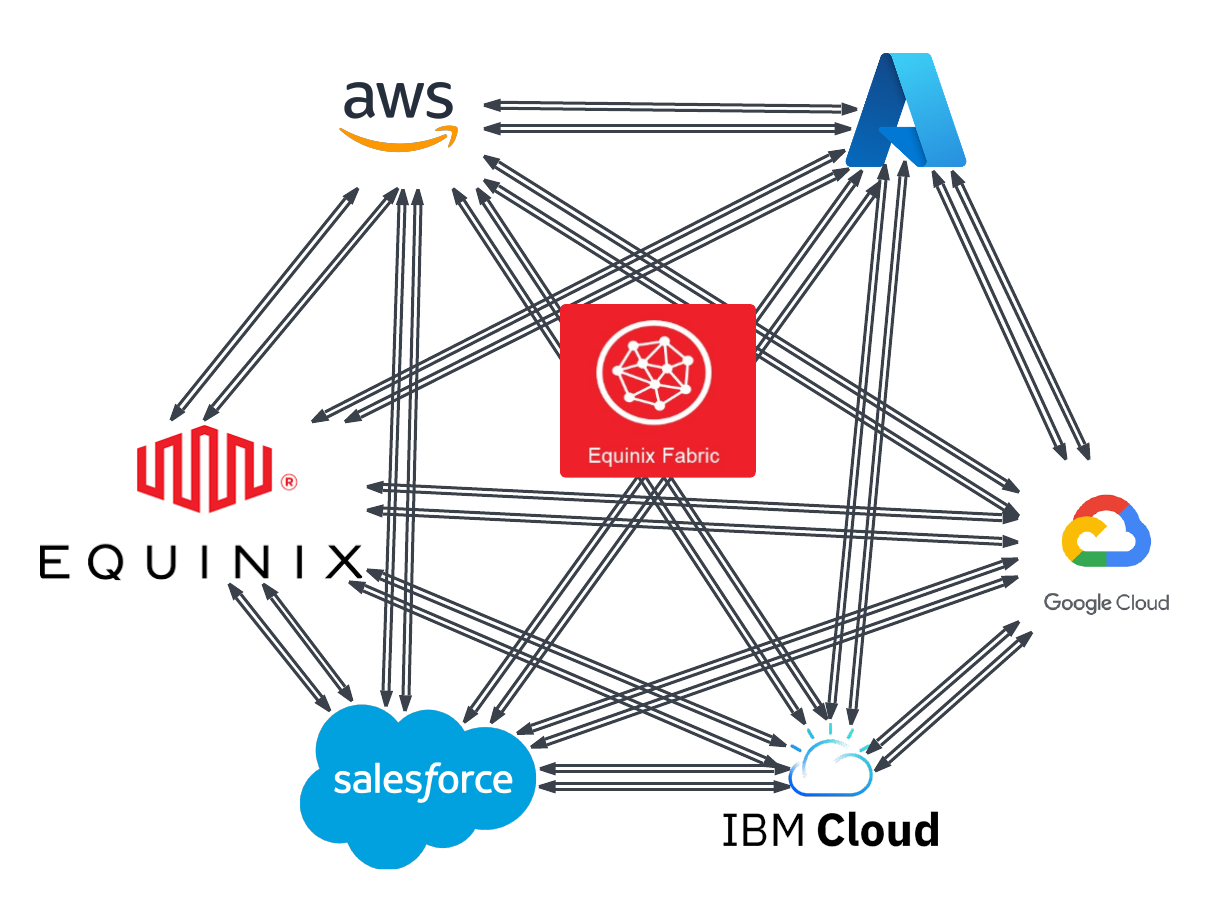
With FCR, all of those complex connections are replaced with just 6 connections, or 12 redundant, to the FCR. You save on the costs of VCs, and the many costs of each interconnection endpoint at each cloud provider. The cost savings can add up quickly.
Further, you only need to manage the routing of each endpoint to the FCR, and then the FCR manages the routing among all of the endpoints. This greatly simplifies routing and control, reducing effort and improving audit and compliance.

Second, if you have connections that do not overlap, but need tighter control and auditing, FCR can provide a single point for routing and control. Let's look at another example. You have the following connections, all in the Washington region:
- Google Cloud (us-east-4) to Azure (us-east)
- Equinix Metal (Washington) to AWS (us-east-1)
- Salesforce (USEAST1) to IBM Cloud (us-east)
- Oracle Cloud (US East) to Equinix IBX (DC13)

That's 4 completely unrelated connections, or 8 for redundancy.
Deploying FCR will not save you any connections; in fact, you will add some. Whereas now you have 4 connections, or 8 for redundancy, with FCR, you will have one pair of redundant connections for each endpoint to FCR, meaning 8 connections, 16 for redundancy. However, you will have a single point to manage all of the routing and controls, and precise knowledge of all of the connections and traffic flows, including auditing and security controls.

All of the routing rules and controls are in a single location, allowing the traffic you want, and blocking that which you do not.
Third, if you have the need to create a global network interconnecting all of your endpoints, a mesh built on top of regional FCRs interconnected by an IP-WAN global network provides a simple, cost-effective and easy to manage solution. This is, perhaps, the ideal use case. Each endpoint needs to connect to just one other endpoint, its regional FCR. Whether that endpoint needs to send traffic to another endpoint in the same region, or across the world, the FCRs manage the routing and controls, and the IP-WAN provides the global connectivity. Extending its connectivity to another endpoint is as simple, and as cost-effective, as changing configuration on the FCRs.
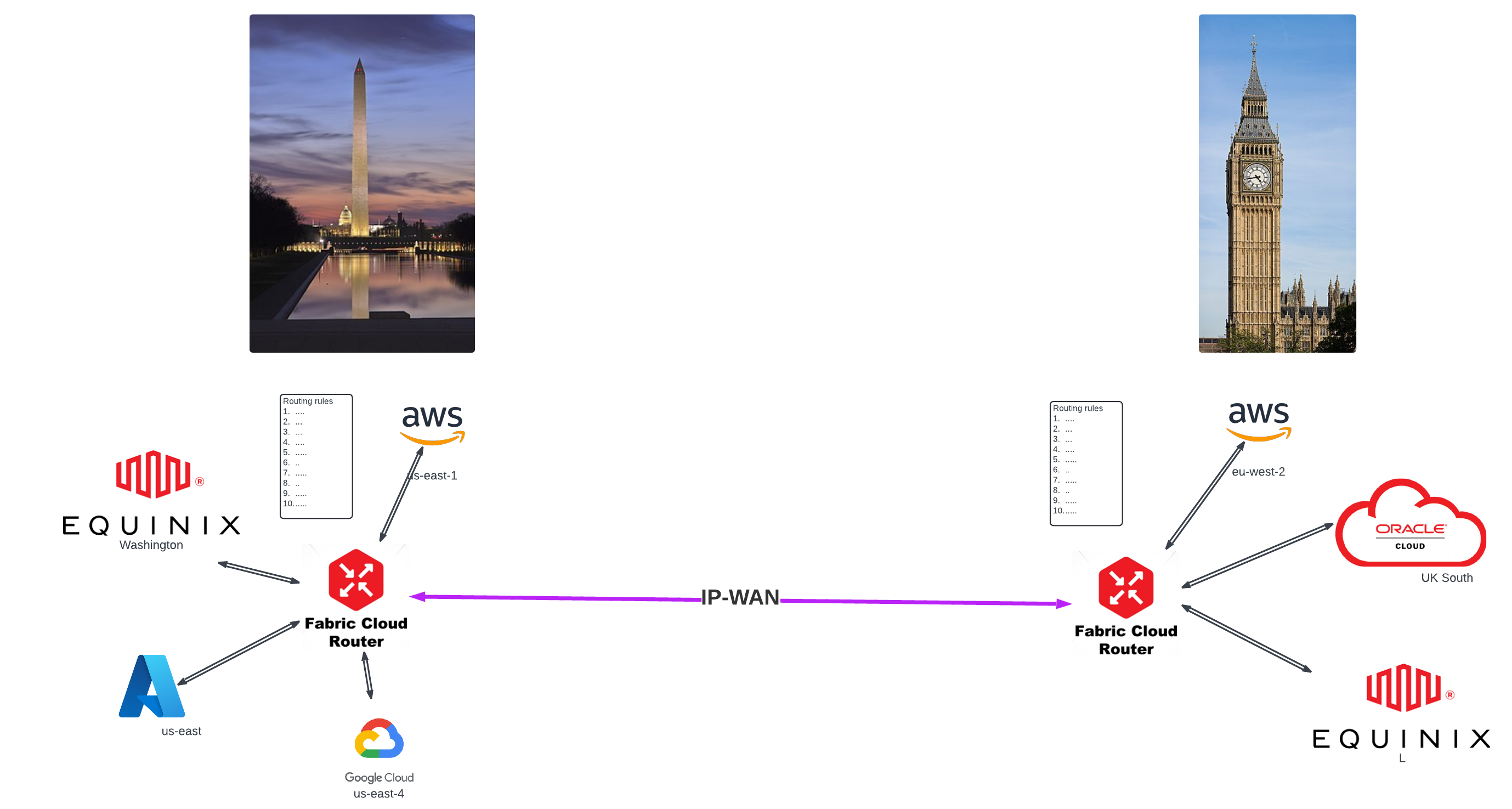
Conclusion
Equinix Fabric Cloud Router (FCR) provides an easy-to-use but incredibly powerful ability to make local networking simple, cost-effective and easy to control, all while making audit and compliance happier. It provides building blocks for simple global networks with optimal design and management.
In future guides, we will show you how to create and manage FCRs, how to connect endpoints to FCRs, and how to create a global mesh network with FCRs and IP-WAN.
You may also like
Dig deeper into similar topics in our archives
Configuring BGP with BIRD 2 on Equinix Metal
Set up BGP on your Equinix Metal server using BIRD 2, including IP configuration, installation, and neighbor setup to ensure robust routing capabilities between your server and the Equinix M...

Configuring BGP with FRR on an Equinix Metal Server
Establish a robust BGP configuration on your Equinix Metal server using FRR, including setting up network interfaces, installing and configuring FRR software, and ensuring secure and efficie...

Crosscloud VPN with WireGuard
Learn to establish secure VPN connections across cloud environments using WireGuard, including detailed setups for site-to-site tunnels and VPN gateways with NAT on Equinix Metal, enhancing...

Deploy Your First Server
Learn the essentials of deploying your first server with Equinix Metal. Set up your project & SSH keys, provision a server and connect it to the internet.